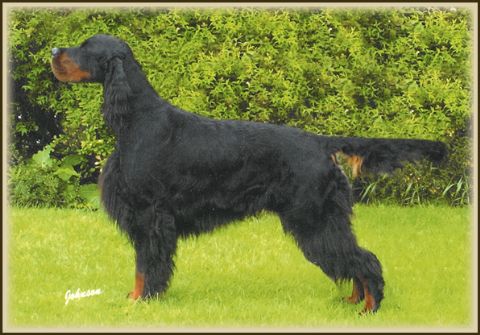The Gordon Setter-History and Standard

Please note, the photograph shown above is subject to copyright and may not be copied or reproduced.
UK Sh Ch Lochfain Not To Be Denied For Bareve
(UK Sh Ch Glynderys High'n Mighty With Liric X UK Sh Ch Lochfain Never A Dull Moment)
In temperament Gordons can be a little aloof towards strangers, but they are extremely loyal and become very attached to their family, which is perhaps why they tend to make better watch dogs than the other Setter Breeds. Overall Gordons are very intelligent and there are currently several who compete very successfully in obedience, field, agility, tracking, jumping and flyball, as well as in the show ring.
Gordon Setters originally evolved from the old setting spaniels, and 'black and fallow' dogs are mentioned as early as the 17th century. However it was Alexander, the 4th Duke of Gordon, who began seriously breeding the Black and Tans at his Castle near Fochabers in north-west Scotland, and it is known that there were black and tan setters at Gordon Castle around 1825. The first Gordon Setters appeared at a dog show in Australia in 1865 ,and although they still aren't a particularly well known breed, there are several dedicated breeders in most Australian states today.
The Gordon is a medium to large breed, that was originally bred to hunt grouse, partridge and pheasant, and they are still used for this purpose today, although they will readily hunt other game such as quail. They are the heaviest of the four Setter Breeds on a weight to height ratio and should look strong and sturdy in appearance. They are black in colour with rich "chestnut red" tan points, but puppies will sometimes have a small white patch on the chest or neck which will diminish as they mature, and usually disappear altogether. The coat is short on the body, but becomes longer on the ears, throat, chest, belly, tail, and on the backs of the front and rear legs.
The dog's coat will require regular brushing to ensure that it remains free of matts and tangles, and some scissoring will be necessary on the throat, around the ears, and on the feet, to keep the dog tidy. It is important to ensure that the feet are kept trimmed, especially between the toes, otherwise the dog will tend to pick up mud and grass seeds.
Gordon Setters are generally free of any major health problems, but like most large breeds they can be very occassionally prone to hip dysplasia and I recommend that all breeders x-ray their stock prior to breeding. A DNA test for the presence of the PRA gene (rcd4) is also something we highly recommend. There have also been a few instances of bloat within the breed.
The Gordon is an active breed that needs regular exercise, but they are usually quiet and sedate around the house providing their exercise requirements are met. Like all dogs they require training if they are to become a well adjusted and obedient family pet, and it is recommended that new owners enrol their puppy in an obedience club as soon as it is old enough.
Those who are "owned" by a Gordon, are truly blessed!
|
Gordon Setter Standard - ANKC GENERAL APPEARANCE - Stylish dog, with galloping lines. Consistent with its build which can be compared to a weight carrying hunter. Symmetrical in conformation throughout. |
Contact Details
Steve,Carolyn,Laura Bennett + Sarah Auld & FamilyAdelaide Hills, SA, Australia
Phone : +61414930223
Email : [email protected]
